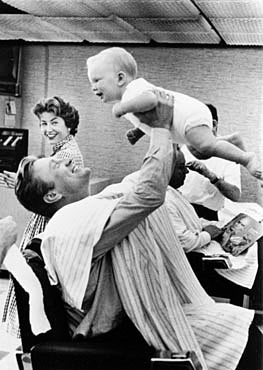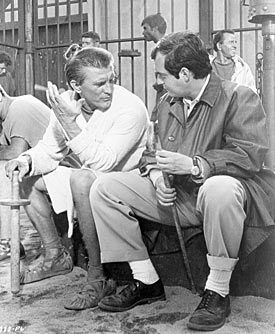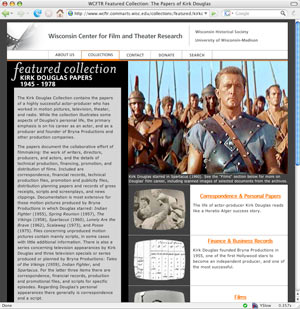A glimpse into Kirk Douglas: Film center shares online collection
Kirk Douglas was Spartacus. But that’s not all. The iconic, dimple-chinned movie star was also a powerful producer who blazed a trail and took command of his own acting career in the new era of American filmmaking that followed the demise of the Hollywood studio system.

“Comes a time in every young man’s life when he must get his first haircut,” reads a caption that accompanied this 1956 photo of Kirk Douglas with his son Peter at the Beverly-Wilshire Health Club, where “Kirk keeps in trim for his rugged movie roles.”
Photo courtesy: Wisconsin Center for Film and Theater Research
For the first time, letters, photos and other documents Douglas donated to the Wisconsin Center for Film and Theater Research are available online through a new Web site that tells the story of his career both in front of the camera and behind the scenes. The site marks a new push by the center, operated by the University of Wisconsin–Madison’s Department of Communication Arts in cooperation with the Wisconsin Historical Society, to move some of its vast collection into the digital age.
The Douglas site gives not only scholars, but also anyone with a love of movies, television and theatre more access to the impressive and authoritative materials from his personal papers. Featured items in the collection include early studio portfolio shots, publicity photographs and detailed records from his company, Bryna Productions, which made “Spartacus” and 17 other films.
The site highlights the kind of information that won’t pop up during an Internet search and would typically be buried in the Web site of any archive, claims Michele Hilmes, the center’s director and a professor of media and cultural studies.
“We’re trying to carve out that ground and I don’t know anybody else who’s taking this particular strategy right now,” Hilmes says.
Douglas donated 60 boxes to the center in the 1960s after then-director Tino Balio approached him about entrusting his legacy to UW–Madison.
Balio, now an emeritus professor of communication arts, made the university a major player in the world of film archives with the acquisition of the massive United Artists collection, which includes every film released by Warner Bros., RKO and Monogram Studios between 1930 and 1950. He convinced donors, including Douglas, that UW–Madison was a serious research institution looking to provide students and scholars with resources to study the history of film, television and theater, and that it would take the steps necessary to archive and preserve those materials.
“It is the first university, as far as I know, to see the significance of such collections in tracing the historical development of filmmaking as one of the most important modern art forms. I am relieved that there will be a proper home for this part of my life.”
Kirk Douglas, in a letter explaining his reasons for choosing Wisconsin to house his papers
“I just built a case for Kirk Douglas that he responded to,” says Balio, who met with Douglas in Los Angeles to finalize the donation. “He clearly was a man of substance who had thought about these things.”
The site includes a copy of a letter Douglas sent to Balio in 1969, in which the actor provides his reasons for choosing Wisconsin to house his collection.
“It is the first university, as far as I know, to see the significance of such collections in tracing the historical development of filmmaking as one of the most important modern art forms,” Douglas wrote of UW–Madison. “I am relieved that there will be a proper home for this part of my life.”
Douglas, born to Russian immigrant parents in 1916, began his acting career on the New York stage and then moved on to Hollywood and the movies. When the big studios faded in power, he launched his own independent production company in 1955, named for his mother, and brokered deals to work with major talents in the industry, including Laurence Olivier, Stanley Kubrick and John Huston. The site includes a status report from 1957 on various film projects Douglas was considering, including well-known movies his production company did not end up making such as “Ben-Hur” and “The Maltese Falcon.”
The online collection includes early studio portfolio shots, publicity photographs and detailed records from his company, Bryna Productions.
“He was one of the few stars during this period who were able to take advantage of their own stardom — and to determine their own future. He is significant in that respect,” Balio says. “He was able to perpetuate his career and have control over it, rather than being a subordinate.”
Publicity photographs and an accompanying press release about his son Peter’s first haircut displayed on the site show how Douglas took control of his publicity in a way today’s stars would envy.
Another piece of the collection shows a letter Douglas wrote directly to his fan club and a note he wrote his longtime publicist, Warren Cowan, suggesting a possible story to pitch to the press contrasting roles playing a GI and appearing as Ulysses in Homer’s Odyssey.
The site also pulls back the curtain on Douglas’s efforts to make “One Flew Over the Cuckoo’s Nest” into a film after he starred in the 1960s Broadway play adapted from the book. Letters from 1970 exchanged between Douglas and author Ken Kesey show Douglas’s frustration with the lack of progress on the project; his son Michael eventually produced the 1975 movie version starring Jack Nicholson.
“We’d go into the archive and get boxes out and we’d say, ‘Look at this! Wow, read this! This is really cool!’ The hardest part was limiting what we were going to put online,” Hilmes says. “We just could have gone crazy. I think with some of it we did go a little crazy.”

Douglas and director Stanley Kubrick talk on the set of “Spartacus.” One of Douglas’ best-known films, it went on to win a Golden Globe Award for best picture in 1960. “‘Spartacus’ took three years out of my life — more time than the real-life Spartacus spent waging war against the Roman Empire,” he said.
Photo courtesy: Wisconsin Center for Film and Theater Research
The center is using financial contributions from UW–Madison alumnus Stephen P. Jarchow, chair of the board of Regent Entertainment and founder and CEO of Here! Networks, to appoint graduate students as summer fellows to develop featured collections for the Web. Jarchow donated $20,000 to the center during the last seven years to support its efforts. Hilmes says future candidates for the project include the television show “Bonanza,” as well as the center’s collection on the Hollywood Ten, a group of artists, including Spartacus writer Dalton Trumbo, who were blacklisted in the 1950s.
The Douglas Web site includes a December 1988 article from Variety detailing an award he won from the American Civil Liberties Union for his role in ending the Hollywood blacklist. The papers Douglas donated to the center include a considerable exchange he had with his main producer, Ed Lewis, about how to credit Trumbo on “Spartacus,” including the possibility of using a pseudonym.
“People in the industry knew Dalton Trumbo was working on Spartacus. It had become a flimsy fiction and Douglas didn’t want to maintain that anymore. He thought it was ridiculous and just pulled the veil off, but somebody had to be the first to do that,” Hilmes says. “After that happened, other people finally had the courage to step up and do the same thing.”
Tags: arts, College of Letters & Science, film, history, humanities





